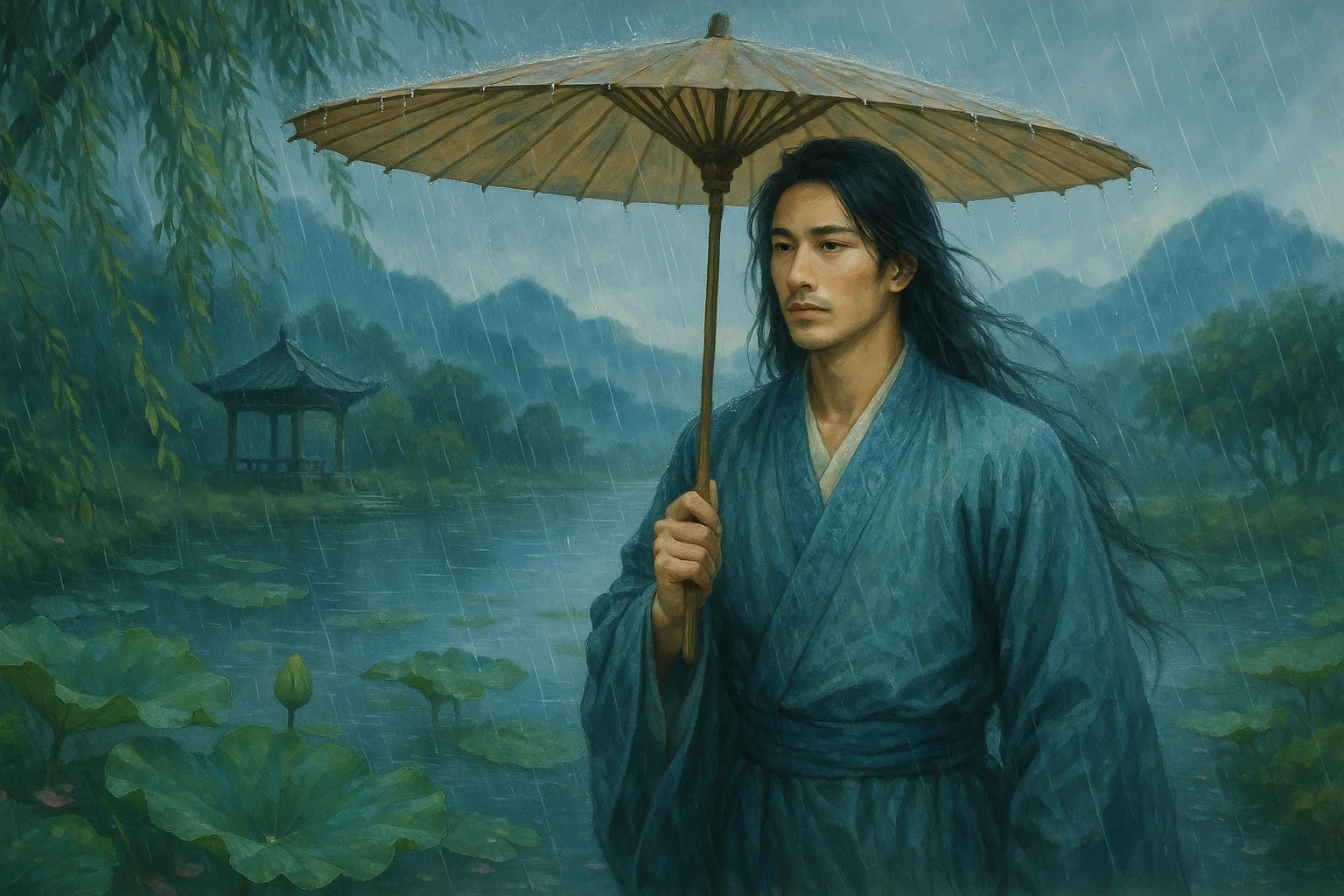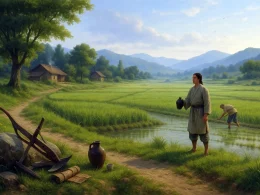The willow pond swells with the fresh spring tide,
A skiff rows on with oars doubled aside.
Leaning on the curved tower, I gaze in vain—
Spring sorrows weigh everywhere the same.
Flower petals flutter by others' view,
At sunset, crows seek roosts anew.
I ask the painted tower's western side—
Dusk clouds near heaven's edge abide.
Original Poem
「清平乐 · 柳塘新涨」
柳塘新涨。艇子操双桨。
闲倚曲楼成怅望。是处春愁一样。傍人几点飞花。夕阳又送栖鸦。
吕本中
试问画楼西畔,暮云恐近天涯。
Interpretation
This lyric was composed during the Southern Song Dynasty, likely after Lü Benzhong’s southward migration to the river towns of Jiangnan. The wounds of the fallen Northern Song and the Jin invasion still lingered, leaving scholars steeped in a collective melancholy. In these water-bound towns, spring rains swelled ponds, boats glided along canals, and waterside pavilions like "winding towers" and "painted balconies" framed the scenery. Amid an era of surface prosperity but inner desolation, the poet weaves willow ponds, drifting petals, returning crows, and dusk clouds into a tapestry where spring’s beauty intertwines with sorrow—a quintessential Southern Song lyric blending nostalgia, displacement, and evening waterscapes into a scene "beautiful yet aching."
First Stanza: "柳塘新涨。艇子操双桨。闲倚曲楼成怅望。是处春愁一样。"
Liǔ táng xīn zhǎng. Tǐngzi cāo shuāng jiǎng. Xián yǐ qū lóu chéng chàng wàng. Shì chù chūn chóu yīyàng.
The willow pond swells anew,
a boatman plies twin oars.
Leaning idle on the winding balcony,
I gaze—and sorrow takes me.
Everywhere, spring’s grief is the same.
The stanza opens with "willow pond swells," marking spring’s arrival. Yet the poet, rather than delighting in the scene, turns inward: "idle on the winding balcony" shifts to contemplation, and "spring’s grief is the same" universalizes his melancholy, mirroring the shared trauma of displaced scholars.
Second Stanza: "傍人几点飞花。夕阳又送栖鸦。试问画楼西畔,暮云恐近天涯。"
Bàng rén jǐ diǎn fēi huā. Xīyáng yòu sòng qī yā. Shìwèn huà lóu xī pàn, mù yún kǒng jìn tiānyá.
A few stray petals brush my sleeve,
the sunset sees crows home again.
If I ask what lies west of the painted tower,
the dusk clouds may touch the sky’s edge.
Fleeting images—petals, crows—evoke transience. The closing line stretches the gaze beyond the tangible: "dusk clouds near the sky’s edge" merges the horizon with emotional distance, a subtle metaphor for exile and unbridgeable separation.
Holistic Appreciation
Though depicting a spring evening by a willow pond, this lyric transcends mere scenery. Beauty here sharpens sorrow, as petals and crows—emblems of time’s passage—deepen the poet’s solitude. The progression from pond to balcony to horizon mirrors a journey from observation to introspection to existential longing. The result is a layered portrait of a man who, amid spring’s vibrancy, carries autumn in his heart—grieving both personal isolation and a lost era.
Artistic Merits
- Scene-Emotion Fusion
Landscapes are never neutral; willow ponds and dusk clouds mirror inner desolation. - Kinetic Stillness
Boatmen rowing, petals drifting—these movements contrast with the poet’s fixed gaze, heightening his contemplative stasis. - Horizon of Longing
The final line’s "sky’s edge" (tiānyá) stretches the poem’s scope beyond the visible, blending physical and emotional exile. - Economy of Language
Simple diction ("swells," "idle," "gaze") belies profound resonance, hallmark of Song lyricism’s restrained depth.
Insights
This poem reminds us that external beauty cannot always soothe inner turmoil. The poet’s spring is lush yet laced with grief, proving that environment and emotion exist in dialogue—not hierarchy. True solace lies not in flawless scenery but in reconciling heart and horizon. Lü Benzhong’s quiet ache, distilled into drifting petals and distant clouds, speaks to anyone who has felt displacement’s pang or time’s inexorable pull. His lyric, like dusk itself, lingers long after the last line.
About the Poet

Lü Benzhong (吕本中 1084 - 1145), a native of Shouxian in Anhui, was a renowned poet and Neo-Confucian scholar of the Southern Song Dynasty. As a key theorist of the Jiangxi Poetry School, he proposed the concept of "living method" (huofa), advocating for natural variation within established poetic rules. With over 1,270 surviving poems, his Genealogy of the Jiangxi Poetry School (Jiangxi Shishe Zongpai Tu) established Huang Tingjian as the school's patriarch, profoundly influencing Song poetic theory and serving as a bridge between the Jiangxi School and the Four Masters of the Mid-Song Revival.












